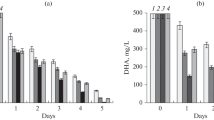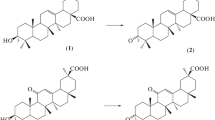Abstract
During growth on ferulic acid, Halomonas elongata DSM 2581T was capable of promoting the formation of a significant amount of vanillic acid. The products were confirmed by high-performance liquid chromatography and gas chromatography mass-spectrometry analyses. To enhance the formation of vanillic acid and prevent its degradation, a resting-cell method using Halomonas elongata was developed. The growth state of the culture utilized for biomass production, the concentration of the biomass, the amount of ferulic acid that was treated and the reutilization of the biomass were optimized. The optimal yield of vanillic acid (82%) was obtained after a 10-h reaction using 10 mM ferulic acid and 5 g/l of cell pregrown on ferulic acid and harvested at the end of the exponential phase.





Similar content being viewed by others
References
Abdelkafi S, Sayadi S, Ben Ali Gam Z, Casalot L, Labat M (2006a) Bioconversion of ferulic acid to vanillic acid by Halomonas elongata isolated from table-olive fermentation. FEMS Microbiol Lett 262:115–120
Abdelkafi S, Labat M, Casalot L, Chamkha M, Sayadi S (2006b) Isolation and characterization of Halomonas sp. strain IMPC, a p-coumaric acid-metabolising bacterium that decarboxylates other cinnamic acids under hypersaline conditions. FEMS Microbiol Lett 255:108–114
Abdelkafi S, Chamkha M, Casalot L, Sayadi S, Labat M (2005a) Isolation and characterization of a novel Bacillus sp., strain YAS1, capable of transforming tyrosol under hypersaline conditions. FEMS Microbiol Lett 252:79–84
Abdelkafi S, Chamkha M, Labat M, Sayadi S (2005b) Biosynthèse de l’acide p-hydroxyphénylacétique par une nouvelle souche Bacillus sp., isolée à partir des eaux de fermentations des olives de table tunisiennes. Microbiol Hyg Alim 17:37–42
Allouche N, Sayadi S (2005) Synthesis of hydroxytyrosol, 2-hydroxyphenylacetic acid, and 3-hydroxyphenylacetic acid by differential conversion of tyrosol isomers using Serratia marcescens strain. J Agric Food Chem 53:6525–6530
Allouche N, Damak M, Ellouz R, Sayadi S (2004) Use of whole cells of Pseudomonas aeruginosa for synthesis of the antioxidant hydroxytyrosol via conversion of tyrosol. Appl Environ Microbiol 70:2105–2109
Alva V, Peyton BM (2003) Phenol and catechol biodegradation by the haloalkaliphile Halomonas campisalis: influence of pH and salinity. Environ Sci Technol 37:4397–4402
Andreoni V, Galli E, Galliani G (1984) Metabolism of ferulic acid by a facultatively anaerobic strain of Pseudomonas cepacia. Syst Appl Microbiol 5:299–304
Andreoni V, Bernasconi S, Bestetti G (1995) Biotransformation of ferulic acid and related compounds by mutant strains of Pseudomonas fluorescens. Appl Microbiol Biotechnol 42:830–835
Argandona M, Fernández-Carazo R, Llamas I, Martínez-Checa F, Caba JM, Quesada E, Moral A (2005) The moderately halophilic bacterium Halomonas maura is a free-living diazotroph. FEMS Microbiol Lett 244:69–74
Barghini P, Montebove F, Ruzzi M, Schisser A (1998) Optimal conditions for bioconversion of ferulic acid into vanillic acid by Pseudomonas fluorescens BF13 cells. Appl Microbiol Biotechnol 49:309–314
Bonnin E, Brunel M, Gouy Y, Lesage-Meessen L, Asther M, Thibault JF (2001) Aspergillus niger I-1472 and Pycnoporus cinnabarinus MUCL39533, selected for the biotransformation of ferulic acid to vanillin, are also able to produce cell wall polysaccharide-degrading enzymes and feruloyl esterases. Enzym Microb Technol 28:70–80
Bouallagui Z, Sayadi S (2006) Production of high hydroxytyrosol yields via tyrosol conversion by Pseudomonas aeruginosa Immobilized Resting Cells. J Agric Food Chem 54:9906–9911
Bouaziz M, Sayadi S (2005) Isolation and evaluation of antioxidants from leaves of a tunisian cultivar olive tree. Eur J Lip Sci Technol 107:497–504
Brunati M, Marinelli F, Bertolini C, Gandolfi R, Daffonchio D, Molinari F (2004) Biotransformations of cinnamic and ferulic acid with actinomycetes. Enzym Microb Technol 34:3–9
Civolani C, Barghini P, Roncetti AR, Ruzzi M, Schiesser A (2000) Bioconversion of ferulic acid into vanillic acid by means of a vanillate-negative mutant of Pseudomonas fluorescens strain BF13. Appl Environ Microbiol 66:2311–2317
Donaghy JA, Kelly PF, McKay AM (1999) Conversion of ferulic acid to 4-vinylguaiacol by yeasts isolated from unpasteurised apple juice. J Sci Food Agric 79:453–456
Garcia MT, Ventosa A, Mellado E (2005) Catabolic versatility of aromatic compound-degrading halophilic bacteria. FEMS Microbiol Ecol 54:97–109
Ghosh S, Sachan A, Kumar-Sen S, Mitra A (2007) Microbial transformation of ferulic acid to vanillic acid by Streptomyces sannanensis MTCC 6637. J Ind Microbiol Biotechnol 34:131–138
Huang Z, Dostal L, Rosazza JPN (1993) Mechanisms of ferulic acid conversions to vanillic acid and guaiacol by Rhodotorula rubra. J Biol Chem 268:954–958
Larrouture-Thiveyrat C, Montel MC (2003) Effects of environmental factors on leucine catabolism by Carnobacterium piscicola. Int J Food Microbiol 81:177–184
Mitsukura K, Yoshida T, Nagasawa T (2002) Synthesis of (R)-2-phenylpropanoic acid from its racemate through an isomerase-involving reaction by Nocardia diaphanozonaria. Biotechnol Lett 24:1615–1621
Peng X, Misawa N, Harayama S (2003) Isolation and characterization of thermophilic bacilli degrading cinnamic, 4-coumaric, and ferulic acids. Appl Environ Microbiol 69:1417–1427
Ruzzi M, Barghini P, Montebove F, Schiesser Ponente A (1997) Effect of the carbon source on the utilization of ferulic, m- and p-coumaric acids by a Pseudomonas fluorescens strain. Ann Microbiol 47:87–96
Sayadi S, Allouche N, Jaoua M, Aloui F (2000) Determinal effects of high molecular-mass polyphenols on olive mill wastewater biotreatment. Proc Biochem 35:725–735
Sutherland J, Crawford D, Pometto A III (1983) Metabolism of cinnamic, p-coumaric and ferulic acids by Streptomyces setonii. Can J Microbiol 29:1253–1257
Toms A, Wood J (1970) The degradation of trans-ferulic acid by Pseudomonas acidovorans. Biochemistry 9:337–343
Topakas E, Kalogeris E, Kekos D, Macris BJ, Christakopoulos P (2003) Bioconversion of ferulic acid into vanillic acid by the thermophilic fungus Sporotrichum thermophile. Lebensm-Wiss U-Technol 36:561–565
Unell M, Kabelitz N, Jansson JK, Heipieper HJ (2007) Adaptation of the psychrotroph Arthrobacter chlorophenolicus A6 to growth temperature and the presence of phenols by changes in the anteiso/iso ratio of branched fatty acids. FEMS Microbiol Lett 266:138–143
Ventosa A, Nieto JJ, Oren A (1998) Biology of moderately halophilic aerobic bacteria. Microbiol Mol Bio Rev 62:504–544
Widdel F, Pfennig N (1981) Studies on dissimilatory sulphate-reducing bacteria that decompose fatty acids. Isolation of new sulphate reducing bacteria enriched with acetate from saline environments. Description of Desulfobacter postgatei gen. nov. Arch Microbiol 129:395–400
Acknowledgments
Authors wish to thank Imen Abdelkafi from CNRS for her help. We thank David Navarro from INRA for their help in GC-MS analysis.
Author information
Authors and Affiliations
Corresponding author
Rights and permissions
About this article
Cite this article
Abdelkafi, S., Labat, M., Gam, Z.B.A. et al. Optimized conditions for the synthesis of vanillic acid under hypersaline conditions by Halomonas elongata DSM 2581T resting cells. World J Microbiol Biotechnol 24, 675–680 (2008). https://doi.org/10.1007/s11274-007-9523-3
Received:
Accepted:
Published:
Issue Date:
DOI: https://doi.org/10.1007/s11274-007-9523-3




